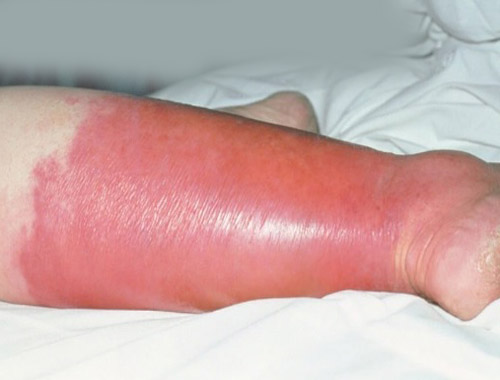Cellulitis

Published: 18 Jun 2025
ICD9: 682.3 ICD10: L03.90 ICD11: 1B70
Cellulitis is a common bacterial skin infection that causes redness, swelling, pain, and warmth in the affected area.
It typically affects the lower legs, but can occur anywhere on the body, including the face, arms, and abdomen.
Here's a breakdown of key aspects of cellulitis:
What causes cellulitis?
![]() Bacteria: The most common causes are *Staphylococcus* and *Streptococcus* bacteria, which often enter through a break in the skin, such as:
Bacteria: The most common causes are *Staphylococcus* and *Streptococcus* bacteria, which often enter through a break in the skin, such as:![]()

![]() Cuts
Cuts![]()

![]() Scrapes
Scrapes![]()

![]() Insect bites
Insect bites![]()

![]() Surgical wounds
Surgical wounds![]()

![]() Dry, cracked skin
Dry, cracked skin![]()

![]() Athlete's foot
Athlete's foot
Symptoms of cellulitis:
![]() Redness: The affected skin becomes red and inflamed. The redness may spread.
Redness: The affected skin becomes red and inflamed. The redness may spread.
![]() Swelling: The area is swollen and feels tight.
Swelling: The area is swollen and feels tight.
![]() Pain: The affected area is tender and painful to the touch.
Pain: The affected area is tender and painful to the touch.
![]() Warmth: The skin feels warmer than the surrounding skin.
Warmth: The skin feels warmer than the surrounding skin.
![]() Other symptoms: May include:
Other symptoms: May include:![]()

![]() Fever
Fever![]()

![]() Chills
Chills![]()

![]() Fatigue
Fatigue![]()

![]() Blisters
Blisters![]()

![]() Skin dimpling
Skin dimpling
Diagnosis:
![]() Cellulitis is usually diagnosed based on a physical examination by a doctor. Blood tests may be done in severe cases.
Cellulitis is usually diagnosed based on a physical examination by a doctor. Blood tests may be done in severe cases.
Treatment:
![]() Antibiotics: Oral antibiotics are the most common treatment. Severe cases may require intravenous (IV) antibiotics in a hospital. It's crucial to finish the entire course of antibiotics, even if you start feeling better, to ensure the infection is completely eradicated.
Antibiotics: Oral antibiotics are the most common treatment. Severe cases may require intravenous (IV) antibiotics in a hospital. It's crucial to finish the entire course of antibiotics, even if you start feeling better, to ensure the infection is completely eradicated.
![]() Elevation: Elevating the affected limb can help reduce swelling.
Elevation: Elevating the affected limb can help reduce swelling.
![]() Pain relievers: Over-the-counter pain relievers like ibuprofen or acetaminophen can help manage pain and fever.
Pain relievers: Over-the-counter pain relievers like ibuprofen or acetaminophen can help manage pain and fever.
![]() Wound care: If there is an open wound, it should be cleaned and bandaged regularly.
Wound care: If there is an open wound, it should be cleaned and bandaged regularly.
Complications:
If left untreated, cellulitis can lead to serious complications, including:
![]() Bacteremia (blood infection): The infection can spread to the bloodstream.
Bacteremia (blood infection): The infection can spread to the bloodstream.
![]() Sepsis: A life-threatening condition caused by the body's overwhelming response to infection.
Sepsis: A life-threatening condition caused by the body's overwhelming response to infection.
![]() Abscess: A collection of pus under the skin.
Abscess: A collection of pus under the skin.
![]() Osteomyelitis: Infection of the bone.
Osteomyelitis: Infection of the bone.
![]() Lymphangitis: Inflammation of the lymphatic vessels.
Lymphangitis: Inflammation of the lymphatic vessels.
![]() Tissue death (gangrene): This is a rare but serious complication.
Tissue death (gangrene): This is a rare but serious complication.
Risk factors:
Factors that increase the risk of developing cellulitis include:
![]() Skin injuries: Cuts, scrapes, insect bites, surgical wounds, etc.
Skin injuries: Cuts, scrapes, insect bites, surgical wounds, etc.
![]() Skin conditions: Eczema, athlete's foot, psoriasis, etc.
Skin conditions: Eczema, athlete's foot, psoriasis, etc.
![]() Obesity:
Obesity:
![]() Weakened immune system: Due to conditions like diabetes, HIV/AIDS, or medications like corticosteroids.
Weakened immune system: Due to conditions like diabetes, HIV/AIDS, or medications like corticosteroids.
![]() Poor circulation:
Poor circulation:
![]() History of cellulitis:
History of cellulitis:
Prevention:
![]() Good hygiene: Wash hands regularly and keep cuts and scrapes clean.
Good hygiene: Wash hands regularly and keep cuts and scrapes clean.
![]() Moisturize skin: To prevent dry, cracked skin.
Moisturize skin: To prevent dry, cracked skin.
![]() Promptly treat skin infections: Address conditions like athlete's foot.
Promptly treat skin infections: Address conditions like athlete's foot.
![]() Manage diabetes: Properly control blood sugar levels.
Manage diabetes: Properly control blood sugar levels.
![]() Avoid tight clothing:
Avoid tight clothing:
Important Note: Cellulitis can be a serious infection, and it's essential to seek medical attention promptly if you suspect you have it. Self-treating with home remedies alone is not recommended. A doctor can properly diagnose the condition and prescribe appropriate treatment to prevent complications.